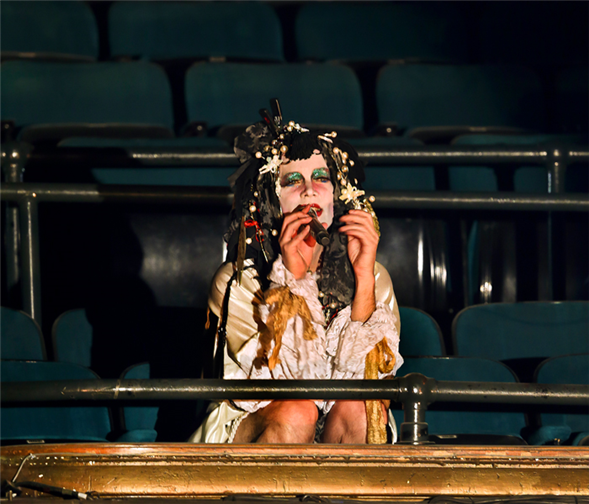Translate Page

The title of Taylor Mac's latest work is quite literal. A 24-Decade History of Popular Music does indeed cover 240 years of beloved tunes, featuring over 246 songs dating all the way back to the American Revolution. No wonder the piece, which plays at St. Ann's Warehouse through Oct 8, has been called a "staggering undertaking."
Though Mac – a writer, performer, and sui generis artist – will be prominently featured throughout, no fewer than 76 special guests will appear over the course of the run. Each act spans three decades, and each decade gets an hour of stage time. (For the especially stalwart, the performance on Oct 8th is a 24-hour non-stop marathon in which all acts, covering music from 1776-2016, are performed.)
At the center of it all, alongside Mac, is his longtime collaborator Matt Ray, who music directs and has arranged all the songs. He also leads a 24-person orchestra (with four back-up singers) and plays piano and sings himself.
"I have been helping to create this project from the beginning," Ray says, noting that every hour features one less musician. "We start with 24, and by the last hour it's just Taylor. So we have everything from larger orchestral pieces to much smaller arrangements."
In terms of arranging, this slow erosion of musicians has created an interesting challenge. "When you know you're going to lose a musician, you need to figure out which one is best to lose, or if it's better to completely reconfigure for an hour," Ray says.
Instead of sticking to strictly historic modes of song, Ray and Mac have taken liberties with their treatments. "We like to serve the story that Taylor wants to tell," says Ray. "Taylor has a subjective view of American history. He wants to present a more queer version of American history and untold stories as he sees them. He likes to say the piece is reminding people of things they've forgotten, dismissed, or buried."
A 24-Decade History of Popular Music has been developed over five years, with public performances and workshops throughout. Audience involvement has been key when it comes to deciding how certain songs will work. A classical song, for instance, might have a punk verse in the middle to picks things up and to let Mac to do something specific with the audience. "When we do 1846, it's a dual between Walt Whitman and Steven Foster to determine who is the real father of American song," says Ray. "We give Steven Foster's songs a kind of polka treatment and then Taylor reads Whitman poems."
Older songs are especially open to tinkering, since there are no recordings to accompany sheet music. Contemporary songs, meanwhile, have presented a choice of honoring the well-known original or taking more radical digressions (so long as they serve the story.)
"One workshop revealed that a way to make a song work was to give it a rock verse," says Ray, who emphasizes how "highly interactive" Mac shows are. "His audience is asked to do things and participate. It's gentle and fun, and it's a way of engaging the audience in the process of the show so that it feels open. Ultimately it feels like we are making the show together."
Deterioration, and the question of how we support each other as we lose power, is at the core of the project. It's tempting to think the 24-hour marathon performance will be the cumulative event, but Ray doesn't see it that way.
"We have been making the show for five years and asking audiences to help us make the show," he emphasizes. "We consider the development a part of the show, too. For some people the experience of durational deterioration will be what they want, but that's not the end. We consider the show 'in process' and 'in progress' the whole time. It's whatever is happening in the room. We're always making the show."
--
Eliza Bent is a frequent contributor to TDF Stages.
Photos by Jim Norrena. Top photo: Taylor Mac in a scene from the show.
TDF Members: Go here to browse our discounted tickets for theatre, dance, and concerts